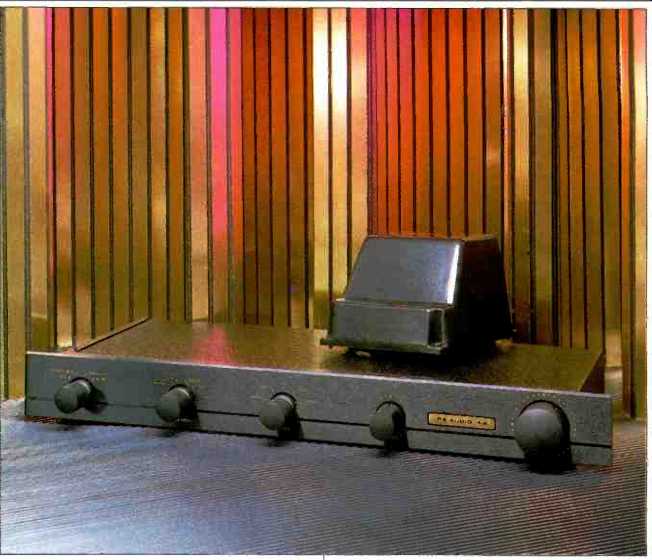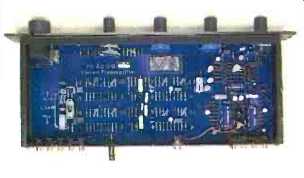
Company Address: 4145 Santa Fe Rd., Bldg. 2, San Luis Obispo, Cal. 93401.
A little over a year ago, PS Audio began producing the Model 4.5 pre amplifier; it offered extraordinary sound, given its cost. For 1988, several circuit improvements were made, and they are incorporated in the Model 4.6.
Among other things, Paul McGowan and company have lowered the open-loop gain, increased the current through the regulators, and added a star-point ground. These improvements are hardly visible, but they are very, very audible.

The 4.6 measures only 19 x 2 1/2 x 7 1/2 inches, but that's because its power transformer (and fuse) are in a separate unit, called the HPCS, that's made to sit on the floor, away from the preamp and your turntable. It measures 4 3/4 x 5 1/2 x 4 1/2 inches, weighs 2 1/2 pounds, and is connected to a special jack on the back of the preamp. Perhaps the first clue that this is not an ordinary device is the power switch.

It really isn't a power switch at all-the unit is always powered up. Labeled "Output," the switch has settings for "Off" (output to the power amplifier is turned off), "Straightwire" (no amplification stages), "High Level" (amplification stages turned on), and "Mono" (amp stages on, mono output). Just to the right of the power switch are two output knobs: "Tape Feed" controls which source is channeled to the tape 1 output, and "Source" controls the output to your power amplifier and speakers. This allows you to listen to one program source (phono, tape 1 or 2, tuner, CD, or AUX) while recording from another. The final front-panel knobs are a small, stepped "Balance" control and a larger, stepped "Volume" control.
Inside the 4.6 is a switch to select MM or MC phono stages as well as space to install resistors to match the system to your cartridge. On the rear panel, you'll find the usual complement of input and output jacks (gold-plated) and the connector for the external power supply. That's it! No filters, tone controls, or devices to change the way your system will sound-and therein lies the beauty of the PS Audio 4.6.
Under the right conditions, this preamp allows you to hear your source material without adding much of anything.
Now, about those conditions: If your speaker's sensitivity is a good match for your power amplifier, you'll be able to use the 4.6 as a passive device and to hear high-level source material (CD, tuner, tape, video, etc.) with only the preamp's wiring and switches intervening. The sound in this mode is glorious. My CD player and tuner never sounded more open and real. The soundstage is wide and deep, almost indistinguishable from playing the CD, tuner, or tape deck directly into the power amplifier.
If the 4.6 and your power amp don't match up, or if a record or tape was recorded at low levels, you won't get enough volume from your system.
Then it's time to switch in the 4.6's amplified stages.
On the 4.6, the phono section is where you are fully aware of all the changes PS Audio has made. I thought that the old 4.5's moving-magnet section was very good, though perhaps it added a small amount of solid-state "steeliness" to the overall sound. Any steeliness I once heard is now almost nonexistent in the 4.6, and the dynamic range of its phono section now seems to be much greater than that of its predecessor. The other major improvement is in the soundstage presented by this preamp. With the right discs, musicians seem to be playing in front of and way behind the speakers, and that sense of depth extends to the outer edge of each loudspeaker. Putting all of this together, PS Audio has come up with the best MM phono stage I've auditioned in a preamp costing $1,000 or less.
The moving-coil section of the 4.5 had not been as satisfying. True, my test location in lower Manhattan is near both the World Trade Center and the Empire State Building, and the r.f. generated by the many transmitters on them doesn't help. I preferred the sound of a moving-coil cartridge played through a pair of Ortofon T-5 transformers and the PS Audio 4.5's moving-magnet section. In the 4.6, there is a big improvement, so unless you have similar problems, you should be very satisfied with its MC stage. The preamp also comes with a small bag of resistors to adjust the load for an MC cartridge. However, I found hunting for the proper color-coded pair of resistors was time consuming, and they yielded no discernible sonic benefits with the cartridge I used.
Whatever source you select, if you need more volume than the "Straightwire" mode can provide, you'll have to move on to the "High Level" stages. It was at this point that the 4.5 began to have a very definite sound of its own, one that was slightly hard and "transistory." I felt that the 4.5's added amplification stages detracted from the overall sound, but this is not the case on the 4.6. Its Class-A high-level stages are much improved. While not perfect, they can now be recommended (even if you do have enough gain in the "Straightwire" mode).
The 4.5, when first marketed, cost $500; its successor costs $659 but is well worth it. The 4.6 is built very well, is very flexible, and sounds great something the competition will be hard pressed to equal or beat. If you currently own a 4.5, PS Audio will upgrade your unit for $100. If you're in the market for a new preamplifier, I suggest you listen to the 4.6 before buying any thing else.
--Gary Krakow
-----------
(Source: Audio magazine, Sept. 1988)
Also see: PS Audio Model PS-II Phono Preamplifier (Feb. 1979)
Phase Linear Model 2000 Preamplifier (Sept. 1976)
= = = =